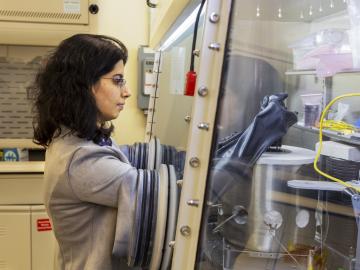
Filter News
Area of Research
- Advanced Manufacturing (6)
- Biology and Environment (14)
- Clean Energy (39)
- Electricity and Smart Grid (1)
- Fuel Cycle Science and Technology (1)
- Functional Materials for Energy (2)
- Fusion and Fission (1)
- Fusion Energy (1)
- Isotopes (5)
- Materials (79)
- Materials Characterization (2)
- Materials for Computing (12)
- Materials Under Extremes (1)
- National Security (34)
- Neutron Science (17)
- Nuclear Science and Technology (4)
- Supercomputing (40)
News Topics
- (-) Materials (143)
- (-) Molten Salt (8)
- (-) National Security (61)
- (-) Quantum Computing (34)
- 3-D Printing/Advanced Manufacturing (120)
- Advanced Reactors (34)
- Artificial Intelligence (91)
- Big Data (53)
- Bioenergy (91)
- Biology (98)
- Biomedical (58)
- Biotechnology (22)
- Buildings (57)
- Chemical Sciences (63)
- Clean Water (29)
- Climate Change (99)
- Composites (26)
- Computer Science (187)
- Coronavirus (46)
- Critical Materials (25)
- Cybersecurity (35)
- Decarbonization (79)
- Education (4)
- Element Discovery (1)
- Emergency (2)
- Energy Storage (108)
- Environment (194)
- Exascale Computing (37)
- Fossil Energy (5)
- Frontier (42)
- Fusion (54)
- Grid (62)
- High-Performance Computing (84)
- Hydropower (11)
- Irradiation (3)
- Isotopes (53)
- ITER (7)
- Machine Learning (47)
- Materials Science (139)
- Mathematics (7)
- Mercury (12)
- Microelectronics (3)
- Microscopy (51)
- Nanotechnology (60)
- Net Zero (13)
- Neutron Science (131)
- Nuclear Energy (107)
- Partnerships (43)
- Physics (61)
- Polymers (33)
- Quantum Science (69)
- Renewable Energy (2)
- Security (24)
- Simulation (47)
- Software (1)
- Space Exploration (25)
- Statistics (3)
- Summit (57)
- Sustainable Energy (125)
- Transformational Challenge Reactor (7)
- Transportation (97)
Media Contacts

Researchers at the Department of Energy’s Oak Ridge, Brookhaven and Idaho national laboratories and Stony Brook University have developed a novel approach to gain fundamental insights into molten salts, a heat transfer medium important to advanced

Using novel data sets and computing systems, researchers at ORNL are simulating how climate change affects the safety and security of the country.

Ten scientists from the Department of Energy’s Oak Ridge National Laboratory are among the world’s most highly cited researchers, according to a bibliometric analysis conducted by the scientific publication analytics firm Clarivate.

A team of collaborators from ORNL, Google Inc., Snowflake Inc. and Ververica GmbH has tested a computing concept that could help speed up real-time processing of data that stream on mobile and other electronic devices.

Amy Elliott, a group leader for robotics and intelligent systems at Oak Ridge National Laboratory, has received the 2021 ASTM International Additive Manufacturing Young Professional Award for her early career research contributions

A team led by the U.S. Department of Energy’s Oak Ridge National Laboratory demonstrated the viability of a “quantum entanglement witness” capable of proving the presence of entanglement between magnetic particles, or spins, in a quantum material.


Oak Ridge National Laboratory researchers have additively manufactured a lightweight aluminum alloy and demonstrated its ability to resist creep or deformation at 300 degrees Celsius.

Research teams from the Department of Energy’s Oak Ridge National Laboratory and their technologies have received seven 2021 R&D 100 Awards, plus special recognition for a COVID-19-related project.

Analytical chemists at ORNL have developed a rapid way to measure isotopic ratios of uranium and plutonium collected on environmental swipes, which could help International Atomic Energy Agency analysts detect the presence of undeclared nuclear


